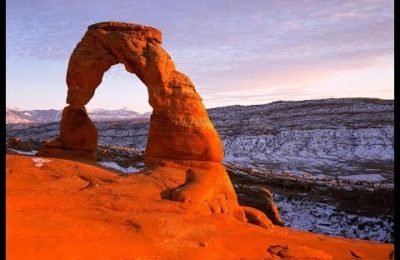
The Earth is home to some truly memorable and extreme places. It has astoundingly high cliffs, depressingly fathomless oceanic ridges, awe-inspiring forests, and seemingly endless deserts. The adventurous spirit of man has conquered many, but some still remain pristine despite human contact. Here are some of these extreme tourist destinations from all over the world.
Many of these extreme destinations are, rightly, some of the most popular in the world, but still manage to present a unique experience to every new traveler, while some are neglected but amazing corners of the world.

Being the hottest place on record, and having that record wrongly erased and then reestablished, adds glamor to this stunning location. It is the lowest and driest point in the U.S., as well as North America, and is situated in the Mojave Desert. It is easily accessible from California, Nevada, and Arizona; the best way to reach it is from Las Vegas. Its pollution-free skies make it one of the best stargazing spots in the world, and camping in the desert to enjoy stargazing is a common recreational activity. For more information on campsites in this amazing but potentially deadly landscape, the NPS website is highly recommended. The best time to visit this terrific place is in the winter, since it is too hot to move about from April-October.

The Dead Sea, situated on the border between Israel and Jordan, is the lowest point on Earth, with its coast situated 424 meters below sea level. It is one of the most salt-rich natural water bodies in the world. It is so salty that its specific density is naturally increased to the point that people can float on top of it without even holding in a gulp of air. The mineral-rich mud around it is claimed to be beneficial for skin ailments, among other things. Though it probably has no effect on serious health conditions, the concentration of minerals may well have a nourishing effect on the skin. However, this very concentration of minerals also means that not much life can flourish in it―hence the name.
The Dead Sea is a day’s trip from Amman, the capital of Jordan, Jerusalem, the disputed capital of Israel, or from Tel Aviv. The best time to visit the Dead Sea is in spring (March-May), or in the early days of winter (September-October). The latter coincides with the Jewish holiday season, which may cause an upturn in prices and a scarcity of rooms. There are numerous hotels in the region, including budget options such as the Massada Guest House or the Ein Gedi Beit Sarah Guest House, and countless 4- and 5-star options.
Visiting the Dead Sea from the Jordanian side is recommended, due to the controversial nature of Israeli politics; American tourists can visit it from both sides with relative ease. Jordan provides visa on arrival for citizens of most countries. The notable exceptions to this are most sub-Saharan countries, Iraq, Iran, Afghanistan, Pakistan, and Colombia. Due to the volatile political situation in the Middle East, it is always recommended to seek the advice of your country’s travel department or experienced travelers whom you know.

Simply one of the most astounding and humbling terrains on Earth, Antarctica is truly a land of extremes. Situated around the Earth’s South Pole, Antarctica is home to some of the fiercest winds and coldest temperatures found on our planet. 98% of it is covered in ice. There are various airline and cruise operators that conduct tours to Antarctica from countries such as New Zealand, Australia, South Africa, Argentina, and Chile; all are comparably competent, so just choose the country that is the most comfortable for you. Due to its location, there is no ‘best time’ to visit, since it is always covered in snow and ravaged by massive winds, but the southern summer (November-March) is the time when all the cruise ships operate. More information about Antarctic travel can be gained from the International Association of Antarctica Tour Operators.

Mount Everest may be the highest mountain on Earth when measured from sea level, but it’s not the tallest point when measured from the center of the Earth. As we know, the Earth is flattened at the poles and expanded at the equator due to the effects of its rotation. This equatorial bulge means that Chimborazo, standing at 6268 meters, is the point farthest from the center of the Earth, even though it’s not even the tallest peak in the Andes, let alone taller than Mt. Everest! Now inactive, it is a popular mountaineering and hiking destination, and is about 145 miles from Quito, the capital of Ecuador. The best place to stay near the mountain is Ambato, about 45 miles from Chimborazo. The equatorial weather of Ecuador means that each day is a virtual carbon-copy of the one before it, so virtually any time is suitable for travel. Guides can be found in any city close to Chimborazo, and the total cost of climbing the mountain could be as low as USD 250!

The Empty Quarter is the huge southern section of the Arabian Desert, and is the second largest sand desert in the world. It spans across Saudi Arabia, Oman, Yemen, and the UAE, covering about 250,000 sq mi (650,000 sq km). It is populated by small organisms, such as spiders, in addition to desert plants. Driving in it in one’s own or rented off-road vehicles is a popular pastime, and Salalah in Oman is the ideal place to start a guided journey!

Mongolia, the least densely populated country in the world (it has more horses than people), is home to some of the most pristine landscape on Earth. Once the scourge of the world due to its nomadic warrior horsemen, and still primarily populated by nomadic cultures, its ancient and largely untouched culture is an eye-opener for the typical modern Western traveler. It is one of the most difficult countries to get across, due to the lack of infrastructure (including roads), but the political situation is quite peaceful. This is not a typical tourist haven, but instead is one of the very best locations for a nomadic traveler.

This area, which is now utterly lifeless and can only be traversed in vehicles specially built for handling off-road work, was once a lake larger than Switzerland. However, thousands of years ago, the lake dried up, leaving this salt-covered soil as an afterthought. Though trees and sporadic life can be found on the occasional island in the mud, it is largely lifeless. Safaris over this treacherous surface can be arranged in Botswana. The most popular option is using quad bikes over this muddy terrain, and stargazing in the middle of nowhere. It can be visited in virtually any time of the year, but different times of the year will provide different treasures for the visitor; for example, the wet seasons brings about migrations of antelopes, zebras, etc., while the dry season invites migratory birds such as flamingos. More information can be found on the official site of Botswana Tourism.

One of the most wildlife-rich, pleasing, and fascinating regions in the world, the Amazon rainforest is truly mind-boggling. About 60% of it is contained within Brazil, which is the ideal country to start your Amazonian excursion. Cities such as Manaus and Cuiaba in Brazil offer easy gateways into this crucial region. Like Ecuador, the equatorial location of the Amazon rainforest means that there is no bad time to visit it. The 2,100,000 sq mi of the Amazon rainforest is more than half of the total area of rainforests left in the world. A huge variety of mammals, birds, and reptiles is seen in this region, including popular species such as jaguar, caiman, anaconda, and various species of tree frogs and macaws. This vital ecosystem is slowly being corroded by the advancement of agriculture, but with the help of environmental groups is still clinging on.

Once the dreaded prison of Soviet Russia, Siberia is now one of the world’s last true great wildernesses, an endless expanse of snow and rough terrain, housing important and threatened animals such as the black and the brown bear, and the Siberian tiger. An important region of tundra and taiga, Siberia is known for its tough, unforgiving weather, and poor infrastructure. Lake Baikal, the deepest lake in the world, is also worth a visit. For adventure junkies, the Road of Bones from Yakutsk to Magadan is an inviting path. The difficulties posed by this untouched―’untouchable’ would be more appropriate―region and the joys offered by it were both encapsulated perfectly in the hit TV series Long Way Round, starring Ewan McGregor and Charley Boorman.

Pakistan is blessed with long stretches of the Karakoram ranges, and at the foothills of K2, the second highest mountain in the world, the awe- and gasp-inspiring region of Concordia can be found. The treks across this fascinating landscape lead to a basin. Skardu, the base for such excursions, is about 400 miles from Islamabad, but flights take only one hour. This trek, with sky-scraping peaks constantly watching over you, can turn into a very spiritual and life-altering experience even if you don’t make it till the end. In contrast to Nepal, where mountaineering infrastructure has been put in place in most destinations, this region is geographically and politically very hard to get into. The risky political situation and the lack of agreeable infrastructure makes this trek extremely fulfilling.
These were some of the most extreme places on Earth. This is a checklist that every adventure junkie must have, in my opinion!



